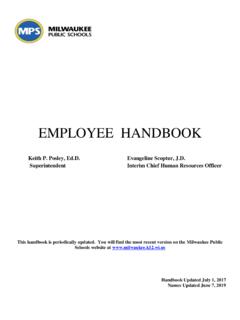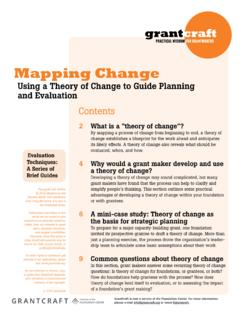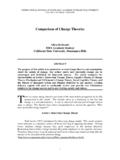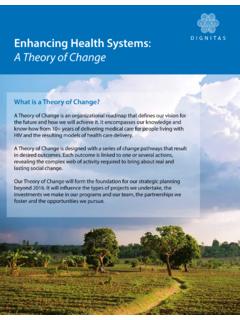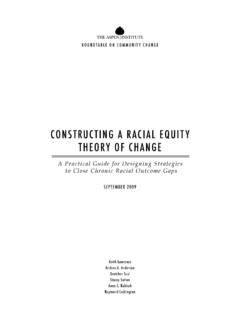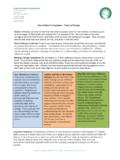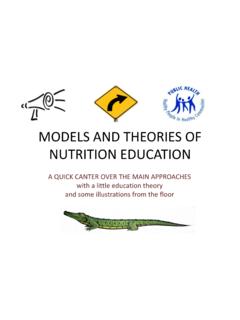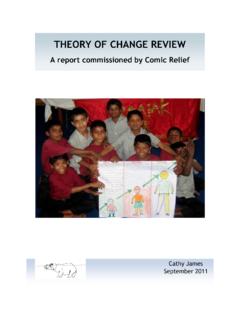Transcription of A Guide for Developing Logic Models Through a Program ...
1 A Guide for Developing Logic Models Through a Program theory of change MPS Department of Research and Development November 2014 Developing Logic Models Through a Program theory of change 3 Table of Contents Introduction .. 4 Core Components of a Logic model .. 6 Developing a Logic model with a theory of change .. 7 The Importance of Research .. 8 Key Stakeholders .. 9 The Problem, Target Population, and Solutions .. 10 theory of change .. 11 Outcomes .. 13 Indicators .. 15 Activities .. 18 Inputs .. 18 Outputs.
2 19 Obstacles and Challenges .. 19 References .. 20 Example: Tutoring Program : Logic model and theory of change Template .. 21 Appendix: Logic model Template .. 22 Developing Logic Models Through a Program theory of change 4 Introduction Many in the social service sector are familiar with the use of Logic Models for identifying outcomes. Incorporation of an intentional identification of a Program theory of change demonstrates why those activities will positively affect the individuals served. The Program theory of change may be implied in a Logic model , but making a conscious effort to explicitly examine assumptions of Program planners about why an intervention might (or might not) work will ensure Program activities logically support the achievement of targeted outcomes.
3 Illustration 1: Logic Models aren t necessarily miracles, but they can certainly be useful. In 2012, the Center for Urban Initiatives and Research at the University of Wisconsin Milwaukee developed a guidebook for MPS on creating Logic Models with a Program theory of change . Building upon this foundation, the MPS Department of Research and Development reworked and revised this resource into a short guidebook and supplemental workbook for use by MPS staff. This Guide provides instructions for engaging in a Program theory of change driven Logic modeling process.
4 It begins by describing Program theory of change and discusses its role as the foundation of the Logic model . Using this theory to create outcomes (including long term, intermediate and short term), outputs, activities, and inputs follows. A separate step by step workbook is available to engage in theory of change Logic modeling, from identifying important stakeholders Through evaluating a Program s process and impact. A recommended template can be found in the Appendix. If you have questions or comments about this Guide , please contact Scott Davis, Research Specialist, at Developing Logic Models Through a Program theory of change 5 What is a Logic model ?
5 A Logic model is a visual representation of a plausible and sensible method of how a Program will work under certain conditions to solve an identified problem. It is a visualization of what a Program will do and what it hopes to accomplish. The purpose of a Logic model is to show stakeholders such as administrators, line staff, funders, and others the underlying rationale for a particular Program . In addition, it identifies the necessary resources for implementation, and the intended effects of implementation. A well crafted Logic model shows, in a simple, common sense manner, the relationship between the underlying rationale and the elements of evaluation.
6 Logic Models provide a snap shot of the Program that is easily understood. These are dynamic documents that change over time based on emerging Program needs, resources, and contextual factors. Logic Models can be thought of as a series of if then statements from assumptions about the underlying problem, to actions taken, to results from those actions. See Figure 1. Figure 1: Logic model Sample: GEAR UP Grant PROBLEM: IF many MPS students and families do not understand academic, social, and financial requirements for a successful postsecondary career,SOLUTION:THEN providing information on postsecondary options will increase students and their families' understanding of the college application process.
7 INPUTS:IFwe align resources to provide opportunities for youth to learn about postsecondary options,ACTIVITIES:THEN we can provide more opportunities for students and their families to learn about the college application :IFstudents learn use the resources made available, OUTCOMES:THEN more MPS students will successfully complete the college application Logic Models Through a Program theory of change 6 Core Components of a Logic model There are many different examples and types of Logic Models . However, there is a central core that is common to all Logic Models .
8 The three core components of a Logic model are the assumptions, the actions, and the intended results. In addition, each core component is comprised of distinct elements which taken in whole provide a high degree of clarity for the Program or project. Assumptions. The assumptions component of a Logic model has two inter connected components: identification of problem, target population, and solutions; and the Program theory of change . Actions. There are three inter connected elements that make up the actions component: inputs, activities, and outputs.
9 They are connected like the mathematical formula: Inputs + Activities = Outputs. These should be clearly connected to the assumptions, and logically support the achievement of intended results. Results. Results are the desired or intended outcomes of Program implementation. These are the changes that one hope will occur in the intended recipients due to the actions. Results should be concrete, measureable, and realistic outcomes in the short term, intermediate term, and long term. Figure 2: Core Components and Elements of a Logic model ResultsLong termIntermediateShort termActionsInputs ActivitiesOutputsAssumptionsProblems, Target Population, SolutionsTheory of ChangeDeveloping Logic Models Through a Program theory of change 7 Developing a Logic model with a theory of change There are many types and examples of Logic Models that one may choose.
10 However, the Logic model framework displayed below is an excellent example because it requires the Program theory of change to be explicitly defined, along with the interconnecting process and impact theories. The theory of change provides the foundation for all of the interconnecting components of the Logic model . Figure 3: theory of change as Foundation of the Logic model The preferred process for Developing a Logic model is based on the creation of the theory of change as the foundation of all activities and outcomes.


